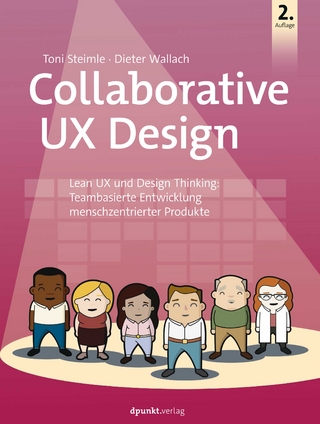Human-Computer Interaction: Human-Centred Design Approaches, Methods, Tools and Environments
Springer Berlin (Verlag)
978-3-642-39231-3 (ISBN)
HCI and Human Centred Design.- HCI Education in Brazil: Challenges and Opportunities.- Semiotics of Interaction: Towards a UI Alphabet.- Engagingdesign - Methods for Collective Creativity.- Toward a New Design Philosophy of HCI: Knowledge of Collaborative Action of "We" Human-and-Technology.- The Link between Inclusive Design and Innovation: Some KeyElements.- Tuning an HCI Curriculum for Master Students to Address Interactive Critical Systems Aspects.- Ageing and Innovation.- Understanding User Experience and Artifact Development throughQualitative Investigation: Ethnographic Approach for Human-CenteredDesign.- User Research for Experience Vision.- Analyzing Varying Environmental Contexts in Public Transport.- The Conceptual Model of Experience Engineering (XE).- User Centered Inclusive Design Process: A 'Situationally-Induced Impairments and Disabilities' Perspective.- Applying Contextual Design to Multiple Teams in Emergency Management.- Visualization and Evaluation for Experience Vision.- Confabulation in the Time of Transdisciplinarity: Reflection on HCI Education and a Call for Conversation.- Proposal for Experience Vision.- Collaborative User Experience Design Methods for Enterprise System.- Evaluation Methods and Techniques.- An Estimation Framework of a User Learning Curve on Web-Based Interface Using Eye Tracking Equipment.- A Grounded Procedure for Managing Data and Sample Size of a Home Medical Device Assessment.- Usability Guidelines for Desktop Search Engines.- Analyzing Face and Speech Recognition to Create Automatic Information for Usability Evaluation.- Linking Context to Evaluation in the Design of Safety Critical Interfaces.- Environmental Evaluation of a Rehabilitation Aid Interaction under the Framework of the Ideal Model of Assistive Technology Assessment Process.- Towards Ergonomic User Interface Composition: A Study about Information Density Criterion.- Human-Machine Interaction Evaluation Framework.- Supervisory Control Interface Design for Unmanned Aerial Vehicles through GEDIS-UAV.- Remote Usability Evaluation of Mobile Web Applications.- Design and Implementation of ErgoIdentifier: A Tool for Automated Identification of Websites Interaction Elements.- A Self-Evaluation Tool for Quantitative User Research within the digital.me Project.- Priming Categorization in a Card Sort.- User Interface Design and Development Methods and Environments Case Study for Experience Vision - Application for PC.- Using the Common Industry Format to Document the Context of Use.- V&V of Lexical, Syntactic and Semantic Properties for Interactive Systems through Model Checking of Formal Description of Dialog.- Formal Pattern Specifications to Facilitate Semi-automated User Interface Generation.- A Mobile Application Flow Representation for Mutual Understanding of IT and Healthcare Professionals.- Communicating Ideas in Computer-Supported Modeling Tasks: A Case Study with BPMN.- Semantic Execution of Subject-Oriented Process Models.- SpecialChallenges for Models and Patterns in Smart Environments.- Parallel Rendering of Human-Computer Interaction Industrial Applications on Multi-/Many-Core Platforms.- A Logical Design Method for User Interface Using GUI Design Patterns.- Developing Mobile Apps Using Cross-Platform Frameworks: A Case Study.- EMIL: A Rapid Prototyping Authoring Environment for the Design of Interactive Surface Applications.- Extending the Information of Activity Diagrams with a User Input Classification.- Patterns and Models for Automated User Interface Construction - In Search of the Missing Links.- Evaluation of User Interface Description Languages for Model-Based User Interface Development in the German Automotive Industry.- An Empirical Study on Immersive Prototyping Dimensions.- From Multicultural Agents to Culture-Aware Robots.- Visual Interfaces Design Simplification through Components Reuse.- Established and Innovative Facets of Interactive Prototypes - A Case Study.- Multi-level Communicability Evaluation of a Prototyping Tool.- Participatory Action Research in Software Development: Indigenous Knowledge Management Systems Case Study.- Enhanced 3D Sketch System Incorporating "Life-Size" and "Operability" Functions.- An Interface Prototyper Supporting Free Design ComponentsSpecification.- Structured Scenario-Based Design Method for Experience Vision.- Requirements for a Definition of Generative User Interface Patterns.- Characterizing Incidents Reporting Systems across ApplicationsDomains.- Method Format for Experience Vision.- Case Study for Experience Vision Designing Notebook PC.- Aesthetics and Kansei in HCI.- Investigating the Effects of Font Styles on Perceived Visual Aestheticsof Website Interface Design.- A Color Schemer for Webpage Design Using Interactive Mood Board.- Study on Effects of Text Decoration for a Text Based Communication Tool in Education.- Ease of Icon Processing Can Predict Icon Appeal.- Basic Study on Kawaii Feeling of Material Perception.- Centrality of Visual Aesthetics in the Online Context: An Assessmentand Empirical Evidence.- The Feeling of Kawaii Is a Function of Interaction.- Comparison of Kansei Information between Joyful and HappyExpressions in Dance.- Study of Kawaii-ness in Motion - Physical Properties of Kawaii Motion of Roomba.
| Erscheint lt. Verlag | 10.7.2013 |
|---|---|
| Reihe/Serie | Information Systems and Applications, incl. Internet/Web, and HCI | Lecture Notes in Computer Science |
| Zusatzinfo | XXII, 640 p. 229 illus. |
| Verlagsort | Berlin |
| Sprache | englisch |
| Maße | 155 x 235 mm |
| Gewicht | 989 g |
| Themenwelt | Mathematik / Informatik ► Informatik ► Betriebssysteme / Server |
| Informatik ► Software Entwicklung ► User Interfaces (HCI) | |
| Schlagworte | Communication Tools • experience vision • HCI education • interactive prototypes • User Interface Patterns |
| ISBN-10 | 3-642-39231-8 / 3642392318 |
| ISBN-13 | 978-3-642-39231-3 / 9783642392313 |
| Zustand | Neuware |
| Haben Sie eine Frage zum Produkt? |
aus dem Bereich




